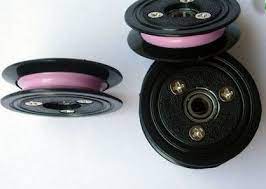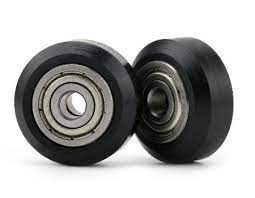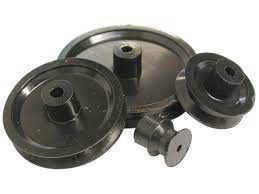Product Description
Customize Plastic wheel Polyurethane PU Roller Bearing
We can do as your size , color ,drawing, or samples.any needs, just contact us any time
| Product name | Plastic ball bearing wheels |
| ltem number | S323Z |
| Weight | 17g |
| Material | Nylon,PU |
| Color | White |
| Outline | White |
| Use | Mechanical equipment such as drawers |
| Size | 6*34.5*11mm(Accept customization) |
| Rolling body | Steel ball |
| Stock | Enough |
1.Delimit
Plastic bearings can be generally divided into plastic rolling bearings and plastic sliding bearings; the friction generated
when plastic rolling bearings work is rolling friction, while the sliding of plastic sliding bearings occurs when sliding; the
frictional friction depends on the manufacturing precision; The amount of friction of the bearing depends mainly on the
material of the sliding surface of the bearing.
2.The main purpose:
Mechanical and electrical equipment, fitness equipment, food machinery, furniture and decorationmaterials 1. High rigidity and high hardness, high impact strength even at low temperatures;
2. Excellent elasticity and good creep resistance For fast quotation, please inform below detials;
1. Product type
2. Size (provide samples or 2d/3d drawings for reference)
3. Material specification (or let us using environment)
4. Quantity request 5. Prefer color Companies strictly enforce the ISO9001(2008)international quality certification system,
the product quality conforms to the eu RoHS standard The company has professional product technical consultation and after-sales service;Good market
reputation (quality assurance, reasonable price, timely delivery!)We will wholeheartedly provide you with
the best quality products, the most thoughtful service! The company has rich experience, strong strength and participated in many high-end exhibitions;
Many partners from other countries are visiting
Cooperate with many CHINAMFG companie s
Q1. We don’t have drawings, can we produce according to the samples we provide?
A1. OK
Q2. How to customize plastic parts?
A2. Customized according to drawings
Q3. Can I make a sample for testing first?
A3. OK
Q4. How long is the proofing cycle?
A4. 2-5 days
Q5. What are your processing equipment?
A5. CNC machining center, CNC lathe, milling machine, engraving machine, injection molding machine,
extruder, molding machine
Q6. What craftsmanship do you have for processing accessories?
A6. According to different products, different processes are used, such as machining, extrusion, injection
molding, etc.
Q7. Can injection products be surface treated? What are the surface treatments?
A7. OK. Surface treatment: spray paint, silk screen, electroplating, etc.
Q8. Can you help assembling the product after it is made?
A8. OK.
Q9. How much temperature can the plastic material withstand?
A9. Different plastic materials have different temperature resistance, the lowest temperature is -40ºC, and
the highest temperature is 300ºC. We can recommend materials according to the working conditions of your
company.
Q10. What certifications or qualifications does your company have?
A10. Our company’s certificates are: ISO, Rohs, product patent certificates, etc.
Q11. How scale is your company?
A11. Our company covers an area of 2,000 square CHINAMFG and has 100 employees /* January 22, 2571 19:08:37 */!function(){function s(e,r){var a,o={};try{e&&e.split(“,”).forEach(function(e,t){e&&(a=e.match(/(.*?):(.*)$/))&&1
| Customized: | Customized |
|---|---|
| Color: | Multiple Colour |
| Type: | Rotating Wheel |
| Surface Treatment: | Chrome Plated |
| Size: | PA |
| Material: | Nylon |
| Customization: |
Available
| Customized Request |
|---|
Are there any limitations or temperature constraints with plastic pulleys?
Yes, there are certain limitations and temperature constraints associated with plastic pulleys. Here’s a detailed explanation:
1. Load Capacity:
Plastic pulleys have a limited load capacity compared to their metal counterparts. While they are suitable for many light to moderate load applications, they may not be suitable for heavy-duty or high-load scenarios. Exceeding the recommended load capacity of plastic pulleys can lead to deformation, premature wear, or failure of the pulley, compromising the overall performance and reliability of the system.
2. Temperature Sensitivity:
Plastic pulleys can be sensitive to temperature variations. Extreme heat or cold can affect the mechanical properties of the plastic material, leading to dimensional changes, reduced strength, or increased brittleness. High temperatures can cause the pulleys to deform or soften, while low temperatures can make them more prone to cracking or breakage. Therefore, it is important to consider the temperature range in which plastic pulleys will be operating and choose materials that can withstand the specific environmental conditions.
3. Thermal Expansion:
Plastic pulleys can exhibit thermal expansion, meaning they may expand or contract with changes in temperature. This can affect the precision and alignment of the pulley system. In applications where precise positioning or tight tolerances are required, thermal expansion of the plastic pulleys should be taken into account to ensure proper functioning of the system. Compensation techniques, such as using adjustable mounting brackets or incorporating thermal expansion calculations, may be necessary to maintain alignment under varying temperature conditions.
4. Chemical Compatibility:
Some plastic materials used in pulleys may not be compatible with certain chemicals or solvents. Exposure to chemicals that are incompatible with the plastic material can lead to degradation, discoloration, or weakening of the pulleys. It is important to consider the chemical environment in which the plastic pulleys will be used and select materials that are resistant to the specific chemicals present in that environment.
5. UV and Weather Resistance:
Not all plastic materials used in pulleys have excellent resistance to ultraviolet (UV) radiation or outdoor weather conditions. Prolonged exposure to sunlight or harsh weather elements can cause degradation, discoloration, or loss of mechanical properties in certain plastics. If plastic pulleys are intended for outdoor or UV-exposed applications, it is crucial to choose materials that are UV-resistant and weather-resistant to ensure long-term durability and performance.
6. Static Electricity:
Some plastic pulleys can generate static electricity during operation. This can be a concern in certain applications where static discharge can interfere with sensitive electronic components or create safety hazards in potentially explosive environments. In such cases, anti-static or conductive plastic materials may need to be used to mitigate the risks associated with static electricity generation.
In summary, plastic pulleys have limitations and temperature constraints that should be considered during their selection and application. These limitations include load capacity, temperature sensitivity, thermal expansion, chemical compatibility, UV and weather resistance, and static electricity generation. By understanding and addressing these constraints, it is possible to use plastic pulleys effectively and ensure their optimal performance and longevity in various mechanical systems.
Can plastic pulleys be customized for specific machinery and equipment?
Yes, plastic pulleys can be customized to meet the specific requirements of machinery and equipment. Here’s a detailed explanation:
Plastic pulleys offer a high degree of design flexibility, allowing for customization to match the needs of different machinery and equipment. Here are some key points regarding the customization of plastic pulleys:
1. Material Selection:
Plastic pulleys can be manufactured using various types of plastics, such as nylon, polyethylene, acetal (POM), or polyurethane. The choice of material depends on the specific application requirements, including factors like load capacity, wear resistance, chemical resistance, temperature tolerance, and desired friction properties. Different materials can be selected to optimize the performance and durability of the pulley in the given machinery or equipment.
2. Shape and Size:
The shape and size of plastic pulleys can be customized to fit the available space and interface with other components in the machinery or equipment. Manufacturers can design pulleys with specific dimensions, such as diameter, width, and bore size, to ensure proper alignment, belt or chain engagement, and tension. Customized shapes can include flanges, grooves, or other features that facilitate efficient power transmission and enhance the overall functionality of the machinery or equipment.
3. Mounting Options:
Plastic pulleys can be customized with different mounting options to suit the specific requirements of machinery or equipment. Mounting options can include bores, keyways, set screws, or other mechanisms that enable secure attachment to shafts or other rotating components. Customized mounting options ensure proper installation and alignment of the pulleys, contributing to reliable and efficient operation.
4. Groove Configuration:
In belt-driven systems, plastic pulleys can be customized with different groove configurations to accommodate specific belt profiles. Pulleys can be designed with V-grooves, flat grooves, or multi-groove profiles, depending on the type of belt being used. Customized groove configurations ensure optimal belt engagement, tracking, and power transmission, minimizing slippage and maximizing efficiency in the machinery or equipment.
5. Surface Finish:
The surface finish of plastic pulleys can be customized to meet specific requirements. This includes factors such as roughness, texture, or the addition of coatings or treatments. For example, pulley surfaces can be polished or coated to reduce friction, improve wear resistance, or enhance corrosion resistance. Customized surface finishes help optimize the performance and longevity of plastic pulleys in the machinery or equipment.
6. Load Capacity and Reinforcement:
If the machinery or equipment operates under heavy loads or high-stress conditions, plastic pulleys can be customized to enhance their load-carrying capacity. Reinforcing elements, such as fibers or fillers, can be added to the plastic material to increase strength and improve overall durability. Customized reinforcement ensures that the plastic pulleys can withstand the specific loads and forces encountered in the machinery or equipment.
7. Application-Specific Requirements:
Plastic pulleys can be customized to meet application-specific requirements. For example, in food processing equipment, the pulleys may need to comply with specific hygiene standards, such as being made from food-grade materials that are easy to clean. In corrosive environments, the pulleys can be customized to exhibit enhanced chemical resistance. Customization allows plastic pulleys to be tailored to the unique demands of different machinery and equipment.
Overall, plastic pulleys can be customized in terms of material selection, shape and size, mounting options, groove configuration, surface finish, load capacity, and meeting application-specific requirements. This customization ensures that the plastic pulleys seamlessly integrate into the machinery or equipment, providing optimal performance, durability, and reliability in their intended applications.
How do plastic pulleys contribute to effective belt or cable operation?
Plastic pulleys play a crucial role in ensuring effective belt or cable operation in numerous applications. Here’s a detailed explanation of how plastic pulleys contribute to effective belt or cable operation:
1. Reduced Friction:
Plastic pulleys are designed to have low friction surfaces. When a belt or cable passes over a plastic pulley, the reduced friction between the pulley and the belt or cable allows for smoother movement. This reduced friction minimizes energy losses, improves efficiency, and reduces wear and tear on the belt or cable. As a result, plastic pulleys contribute to effective and efficient operation by reducing the resistance encountered by the belt or cable during its movement.
2. Noise Reduction:
Plastic pulleys offer inherent damping properties, which help reduce noise and vibration during belt or cable operation. The damping effect of plastic materials absorbs vibrations and minimizes noise generation. This is particularly important in applications where quiet operation is desired, such as in office equipment or household appliances. By reducing noise and vibration, plastic pulleys contribute to effective belt or cable operation by providing a smoother and quieter system performance.
3. Wear Resistance:
Plastic pulleys are often engineered to be wear-resistant. They are designed to withstand the repetitive contact and rubbing of belts or cables without significant wear or damage. The wear-resistant properties of plastic pulleys ensure that the pulley maintains its shape and functionality over time, resulting in prolonged belt or cable life and consistent performance. By minimizing wear and extending the lifespan of the belt or cable, plastic pulleys contribute to effective and reliable operation in various applications.
4. Corrosion Resistance:
Plastic pulleys offer excellent resistance to corrosion. Unlike metal pulleys that may rust or corrode when exposed to moisture or certain chemicals, plastic pulleys remain unaffected by such corrosive elements. This corrosion resistance is particularly beneficial in environments where belts or cables may come into contact with moisture or chemicals, such as in outdoor machinery or marine equipment. By resisting corrosion, plastic pulleys ensure the longevity and reliable operation of belts or cables in harsh conditions.
5. Design Flexibility:
Plastic pulleys offer a high degree of design flexibility. They can be molded into various shapes, sizes, and configurations, allowing for precise customization to match the specific requirements of the belt or cable system. Plastic pulleys can incorporate features such as flanges, grooves, or mounting options directly into the design, ensuring optimal belt or cable engagement and alignment. This design flexibility contributes to effective belt or cable operation by providing a tailored solution that maximizes performance and minimizes the risk of belt slippage or misalignment.
6. Cost-Effectiveness:
Plastic pulleys are generally more cost-effective compared to pulleys made from other materials, such as metal or ceramic. The manufacturing process for plastic pulleys is typically less complex and less expensive, resulting in lower production costs. This cost advantage makes plastic pulleys a cost-effective choice for belt or cable systems, especially in applications where multiple pulleys are required. By offering a cost-effective solution, plastic pulleys contribute to effective belt or cable operation while keeping overall system costs under control.
In summary, plastic pulleys contribute to effective belt or cable operation through reduced friction, noise reduction, wear resistance, corrosion resistance, design flexibility, and cost-effectiveness. By providing smoother movement, minimizing wear, reducing noise and vibration, resisting corrosion, offering customized designs, and being cost-effective, plastic pulleys play a vital role in ensuring the optimal performance and longevity of belt or cable systems in various applications.
editor by CX
2024-03-09




